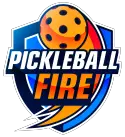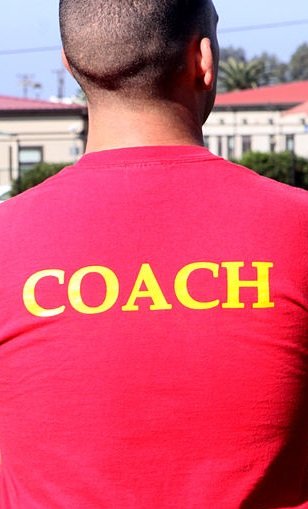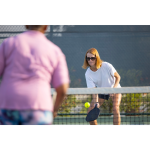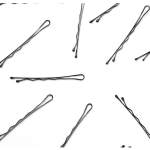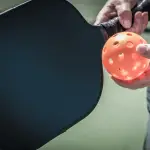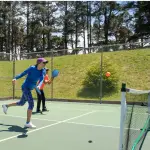With Pickleball on hiatus in most places due to the Coronavirus, I thought I would reach out to Pickleball instructors and ask them to give their #1 tip on what it takes to move up to the 4.0 level. I asked this question to IPTPA Level 2 Certified Pickleball Teaching Professionals. These are players who have passed a written exam, skills test and are observed while teaching a lesson. A number of professional players such as Kyle Yates and Simone Jardim have this certification.
Below you will hear from many teaching professionals from all over the world. Let’s start with Richard Movsessian “Coach Mo”.
Reduce Unforced Errors
The Team With Patience And The Least Unforced Errors Usually Wins.
Richard Movsessian “Coach Mo”, Florida
Some methods of lowering unforced errors are:
1. Do not sacrifice PLACEMENT for POWER.
Work on improving your accuracy and being more consistent and then keep improving your power.
2. SPLIT STEP at the point of contact of your opponent touching the ball. Go quickly into your balanced ready position. Do it every time opponent contacts the ball everywhere on the court.
It is a similar motion as the game of Hop Scotch.
3 Use EXCELLENT SHOT SELECTION preferably down the MIDDLE low to your opponents BACKHAND.
4.MAKE ABOOK ON YOURSELF. Know what you can do consistently and practice what you cannot do consistently.
Eliminate your Back Swing

Players coming from tennis may be used to hitting a swinging volley. But, resist the temptation. Keep your strokes compact especially when you are at the non-volley zone.
Deborah Henwood Alberta, Canada
Eliminate your back swing. Why? When moving from 3.5 to 4.0 you need to be able to handle more pace, and you need to be able to reset the ball. (Slow the play down by softly placing an unattackable shot into the kitchen).
Neither is possible with backswing.
Backswing causes several issues:
1. Backswing causes you to hit a faster paced ball from your opponent, late, resulting in misdirection of the ball. (Out the side usually, or into the net,)
2. Backswing makes it harder for you to control the pace you put on the ball, usually resulting in a pop up, or a shot out the back.
3. Backswing makes it very hard to absorb pace to perform an accurate block or reset.
Instead, always contact the ball in the pickleball zone, which is the V zone in front of you. Do not let your paddle go behind the plane of your body.
How do you do this? Here are a few things to try.
1. Immediately return to the ready position after each shot, using your non dominant hand to lightly touch your paddle as a cue to tell you where the paddle should be, especially when you are moving through the transitional zone.
2. Keep your elbow relaxed and relatively close to your side. It is very hard to swing your paddle behind you when your elbow is in this position
3. Make sure you can always see your paddle in your peripheral vision. This really helps keep your paddle in front of you.
4. Always stop in split step just before the opponent strikes the ball. This prevents you from running past the ball and having to reach behind yourself to strike the ball.
With your paddle up and in front of you at all times, you can not backswing, and you will find it will be very easy to use the correct technique of contacting the ball in the V zone, then pushing forward and through from the shoulder and the lower body on the forward momentum.
Once you have eliminated your backswing, you will see a world of difference in your play, and you will be well on your way to 4.0.
Kitchen Shots (Third Shot and Dinks)
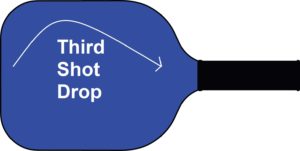
The kitchen is unique to Pickleball. The area is 7 feet from the net and players are not allowed to hit a volley in the kitchen. Pickleball players should move up to just behind the non-volley-zone as soon as possible during a rally.
Alan Bragman, a Pickleball teaching professional from Georgia, gave his advice in one sentence. Learn how to hit a good consistent 3rd shot drop. The third shot drop is hit by the serving team after the serve return. It is a soft shot that helps to neutralize your opponent’s advantage at the net. The third shot drop allows the serving team to move toward the net.
A dink is another kitchen shot which is very effective. Dinks are used to set up more offensive shots.
Jacqueline Paraiso, California
Moving up to the 4.0 level can be difficult and challenging for players. I feel that there are several players who are stuck in 3.5 because they lack the patience to hit dink shots and shots in the kitchen that will set you up for a good shot. Therefore, the #1 top tip I would offer is to learn how to hit kitchen shots (dinks and effective 3rd shot drops). Learning to use the kitchen will set you up for the right opportunity to hit a winning shot. I feel that players below 4.0 really don’t understand how important that tip is until they play in the higher levels. Then they realize that their shots aren’t effective against the higher levels.
Your team serves the ball and the opponents hit a medium-to-deep return…time for the third shot! Some players can hit a consistent third shot drop; which means they can keep a softer shot low enough over the net to prevent the other team from powering a put away. Every player has a decision to face….do I develop a consistent third shot drop? Or do I figure out which ground stroke in my repertoire is the one that I can hit consistently AND keep that shot low enough overt the net to prevent a put away. For you it may be a ground stroke at 50%…or 60%….or 70%…or? Make the decision based upon your game and the consistency of the shot that you choose. It will be the reliable shot that you can keep down….. 10-to-12 inches over the net.
So if you are frustrated by watching your third shot drop….drop into the net. Or if you tend to float your third shot up into the opponents’ power zone, pick a shot that you can rely on and practice it. If, after your third shot the opponents hit a short volley, then you can move forward and hit a soft 5th (or 7th or ?) which will be much more reliable from your closer-to-the-net position.
Getting to the Non-Volley Zone
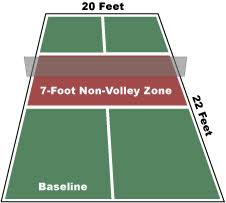
While the teaching professionals above talked about kitchen shots, getting to the non-volley-zone is another key to becoming a 4.0 player.
I’d have to say it would be getting to the NVZ line as quickly as possible with high ready position. Players need to be reminded that getting to the NVZ line quickly isn’t an acquired skill but rather a commitment that any level player can make. Too many players at the 3.5 level still feel they can win from the baseline and aren’t comfortable playing fully forward.
Improving Shot Selection
Improving shot selection is an often overlooked tip which can do wonders for your Pickleball game.
There are so many different tips that would help someone move up to a 4.0 level. I would say my number one tip to help players move up to a 4.0 level would be shot selection. Everyone knows they need to get better at 3rd shot drops, dinking etc, and those all will take a lot of practice. Shot selection will also take practice yet it can be instituted immediately on your next game. The shot you get away with at your local rec games that “always” works with your group, all of a sudden doesn’t work so well when you play a better player. Know where to hit the ball in certain situations, know when to attack the ball, learn when to reset the ball. This often overlooked tip can put you on a path to be a 4.0!
Being Balanced
I think the tip from Joseph Borrelli is one of the most unique tips from the Pickleball teaching professionals. It was something I was working on before the Coronavirus hit as sometimes my left arm flails around when I’m at the non-volley-zone.
Joseph Borrelli, North Carolina
One skill I try to instill in players is not a paddle skill but a balance skill. I call it ‘Keep you body quiet’. When learning to play, most players are intent on moving far too much and too fast to hit and return balls. We teach you to keep your body quiet (still) by staying balanced whether at the kitchen line, hitting dinks or setting up to hit a drop shot, ground stroke or even blocking. The less shuffle or movement of your feet, the better balanced you will be when returning a shot, a less is more concept.
Drill
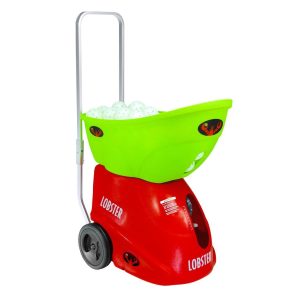
When it comes to most sports, athletes prefer to play rather than practice. But if you want to get to the 4.0 level, you’ll need to spend some time drilling. I like to use my Lobster Pickleball machine if I don’t have a partner who can practice. Listen to what teaching professionals Devin Schmidt and Keith Bing have to say about practicing Pickleball.
My number one tip for players trying to move up to 4.0 level is drill, drill,drill. Find a person or group who is willing to drill as much as possible. Start with the basic shots serve, return, dink, third shot drop. Drill these shots until you can achieve at least 50 quality reps in a row. You can only reach a certain level by “just playing”. The best of the best in any sport practice 2 or 3 times more than they play actual matches or games.
When I was starting out all I did/wanted to do was play and I soon hit a plateau. In order to get to the next level I knew I had to drill. I found a partner and we drilled every morning at 6:00 AM. When we started it was rough and at times boring to hit the same shot over and over. Over time the practice paid off as we both saw exponential growth in our games and winning percentages at tournaments. Practice makes perfect and perfection makes champions.
My answer would be “Drill first and have a play group of 3.5+ to 4.0+ players compete against each other.#1 Drill: Skinny Singles (don’t keep score) .
Keep the Ball Low
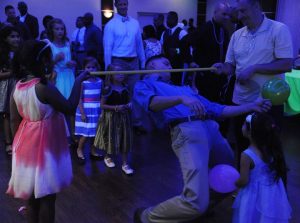
Keeping the ball low is certainly a key to playing at higher levels. I’m always amazed when I watch the professionals at how they do this so consistently. Read on for some great tips from Lisa Palcic on keeping the ball low.
How to move up to the 4.0 level?
There are several ways to answer this question.
The first piece of advice I usually give to my students is a very short, simple answer but is the most necessary skill needed to play at higher levels.
My advice- Work on getting the ball to the ground or your opponents feet as much as possible!
Picture a 3.5 match in your mind. What do you see? Lots of banging the ball hard and half the time it is chest high level to chest high level.
This will NOT work at the higher levels. In order to make it in the higher levels you must be able to keep the ball low and more importantly be able to lower a ball during any rally. So, how do you work on this? The way to be successful at taking ANY ball and lowering it has to do with paddle angles and knowing how the edges or tips of your paddle help direct the ball.
If you are an intermediate level player your ready position isn’t something that you probably think about much, but you should! If your Pro asked you to show them your ready position during a lesson, it’s probably perfect. Tip upwards, paddle not to far away from your body and a nice medium grip hold. However if someone was to record one of your matches, how frequently are you in the correct position during a point at the net. If during a point your paddle tip typically drops to a neutral position or lower than neutral position, it will be almost impossible to get the ball to your opponents feet consistently.
KNOWING YOUR PADDLE
Top Tip or Top Edge -is Located at the top of the paddle and is the corner closest to your chest when holding in ready position.
Bottom Tip or Bottom Edge -is Located at the top of the paddle and is the corner you will use to point at the ball wherever it is on the court.
Once you know your paddle, now you can easily direct your shots to the ground.
Here’s How;
- Use the bottom tip of your paddle to follow the ball on your opponents side the court. As if you are pointing at the ball with your paddle. This helps keep your tip UP as well as puts your shoulders, hips and paddle in the correct position for the ball coming at you.
- If the ball coming at you is above your waist, the way to put it at your opponents feet, is by using the top tip of your paddle as a directional arrow. When you volley the ball if that top corner finishes on top of the ball and pointing where you want the ball to go, it will go there. Like a Directional Arrow!
- If the ball is at your belly, a block or reset shot is your best option. When teaching the block, to help my students understand how to absorb a shot and control it, is by thinking of catching a ball. When you catch a ball, you start out a bit stiff, then you soften your hands to absorb the ball (so it doesn’t POP out of your hands). Now lets add using the bottom tip of your paddle to finish by pointing where you want your ball to go (this will direct it down at the ground).
- If the ball is bellow your belly, use the bottom tip or edge of your paddle to direct the ball to the ground.
- The last tip which can help with ultimate ball control is by understanding and using grip pressure. Grip pressure will help to control the type of shot your are hitting to the ground. If you want to take the pace off, simply loosen your grip towards the end of the shot (just as the ball is leaving your paddle).
Now, use a ball machine or a drilling partner. Put markers down on the court where your opponents feet may be. Then use the tricks above to work on taking any shot hit at you and getting it to one of the targets on the ground!
I have also included the IPTPA 4.0 and 4.5 rating test descriptions.
If you are a 3.5 player, read through this list and see what skills are missing in your game.
(take note how many of these items have to do with BALL CONTROL*)
4.0
• Sustains a volley exchange at the net and beginning to use directional control *
• Can demonstrate a block volley*
• Able to hit winning volley when a ball is popped up*
• Better consistency when performing 3rd shot drop from the baseline *
• Can hit 3rd shot drop from baseline during match play with greater success*
• Moves effectively with partner, easily switching sides, and communicates when required
• Controls play at the NVZ line, by keeping their opponent back if they’re at the baseline *
• Dink with a purpose to elicit a put away shot *
• Can demonstrate an effective poach, and understands when it’s appropriate
• Able to change a fast paced strategy to a slow one and vice versa*
• Can consistently perform an overhead and beginning to place the shot for winners *
• Demonstrates control on forehand ground strokes (direction, depth, height, spin) *
• Demonstrates control on backhand ground strokes (direction, depth, height)*
• Understands proper shot selection to minimize errors*
• Able to adjust to differing ball speeds consistently*
• Uses offensive lobs effectively*
• Beginning to use spin effectively on a variety of shots*
• Maintains greater patience in dinks & rallies*
• Beginning to anticipate shots more frequently (watching opponents paddle face)
4.5
• Consistently punches volley to the appropriate spot on the court *
• Consistently demonstrates a block volley*
• Can demonstrate a swing volley*
• Sustains a controlled volley exchange at the net, with directional control, creating unforced errors *
• Able to consistently hit winning volley when a ball is popped up*
• Can consistently hit 3rd shot drop from baseline during match play*
• Can drive a third shot for power as an option *
• Initiates & maintains an extended dink exchange to elicit a put-away shot*
• Can demonstrate an effective poach, and understands when it’s appropriate
• Able to change a fast paced strategy to a slow one and vice versa*
• Can stack with partner on the serve and the return
• Demonstrates control on forehand ground strokes (direction, depth, height, top spin and under spin/slice)*
• Demonstrates control on backhand ground strokes (direction, depth, height, top spin and under spin/slice)*
• Keeps ball in play during rallies and is aware of minimizing errors *
• Knows the rules including player position, relative to scoring and stacking on the return and serve
• Uses offensive lobs effectively*
• Demonstrates placement, spin and depth on return of serves *
• Can adjust to different ball speeds and spins (serves, ground strokes and volleys) *
• Uses spin effectively on a variety of shots*
Good luck, and remember to always have fun out there!
